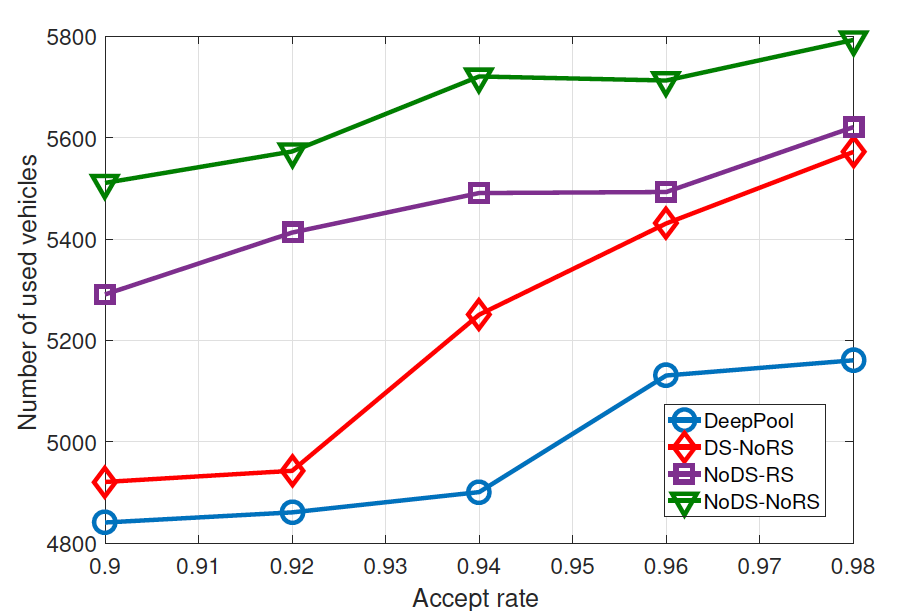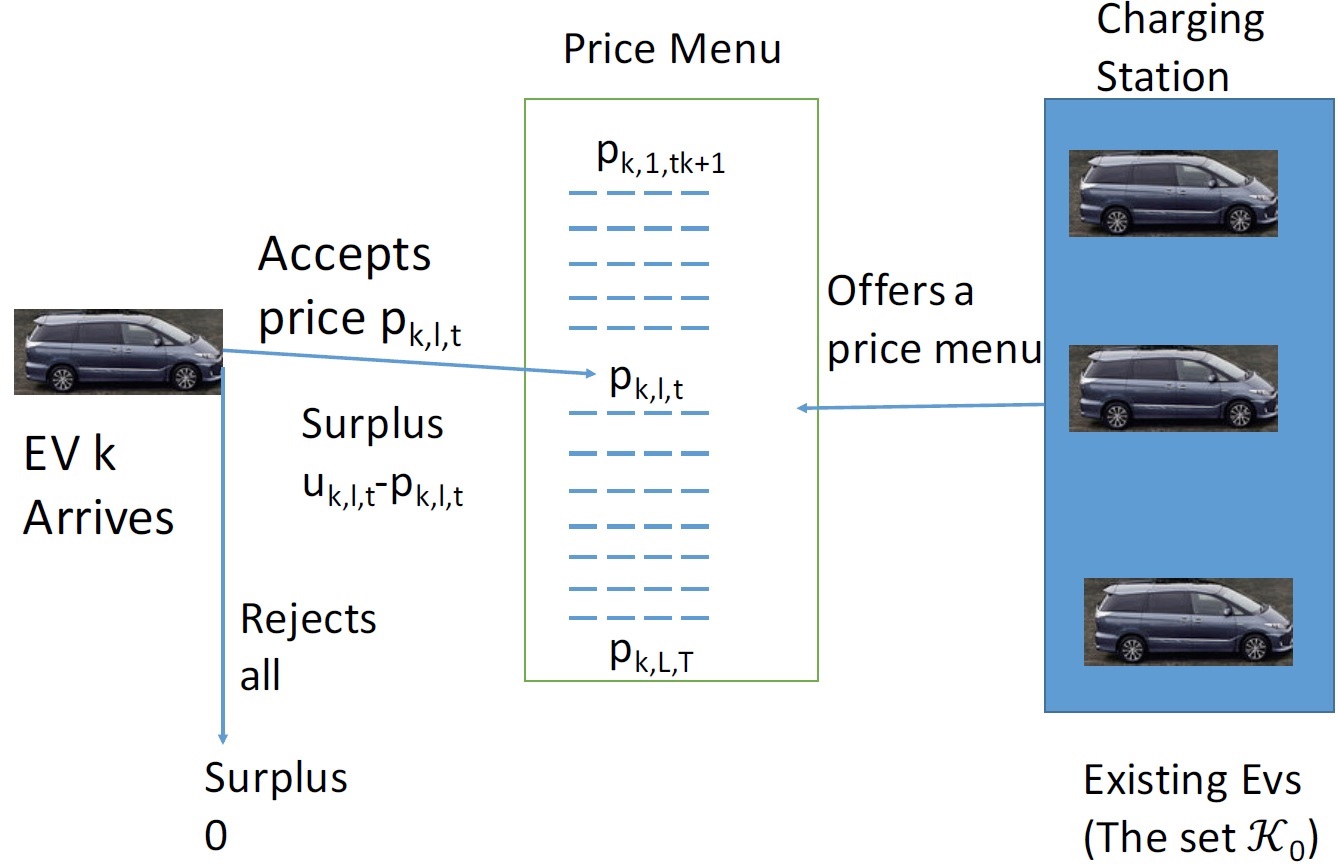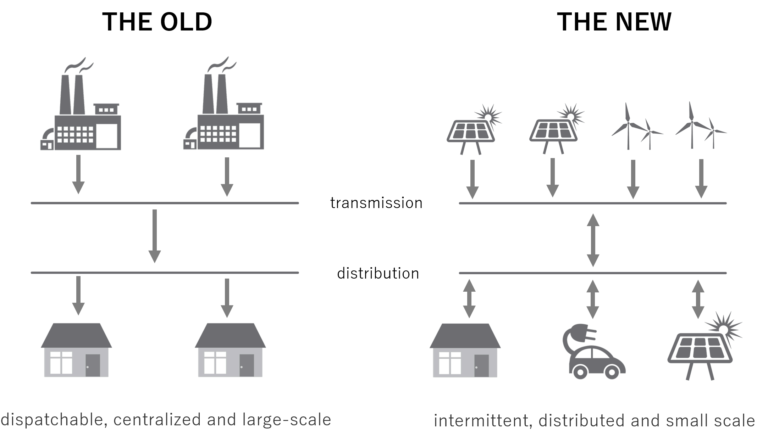Intelligent Transportation Systems:

Ride Sharing:
The success of modern ride-sharing platforms crucially depends on the profit of the ride-sharing fleet operating companies, and how efficiently the resources are managed. Further, ride-sharing allows sharing costs and, hence, reduces the congestion and emission by making better use of vehicle capacities. The figure alongside depicts the improved performance of proposed strategy, DeepPool, for ride-sharing. The number of customers accepted are higher for same number of vehicles used and ride-sharing improves the costs, travel times, and number of customers served.
- Xinwu Qian, Shuocheng Guo, and Vaneet Aggarwal, "DROP: Deep relocating option policy for optimal ride-hailing vehicle repositioning," Transportation Research Part C, vol. 145, 103923, Dec 2022.
- Kaushik Manchella, Marina Haliem, Vaneet Aggarwal, and Bharat Bhargava, "PassGoodPool: Joint Passengers and Goods Fleet Management with Reinforcement Learning aided Pricing, Matching, and Route Planning," IEEE Transactions on Intelligent Transportation Systems, vol. 23, no. 4, pp. 3866-3877, April 2022, doi: 10.1109/TITS.2021.3128877.
- Marina Haliem, Vaneet Aggarwal, and Bharat Bhargava, "AdaPool: A Diurnal-Adaptive Fleet Management Framework using Model-Free Deep Reinforcement Learning and Change Point Detection," IEEE Transactions on Intelligent Transportation Systems, vol. 23, no. 3, pp. 2471-2481, March 2022, doi: 10.1109/TITS.2021.3109611.
- Marina Haliem, Ganapathy Mani, Vaneet Aggarwal, and Bharat Bhargava, "A Distributed Model-Free Ride-Sharing Approach for Joint Matching, Pricing, and Dispatching using Deep Reinforcement Learning," IEEE Transactions on Intelligent Transportation Systems, vol. 22, no. 12, pp. 7931-7942, Dec. 2021.
- Jiayu Chen, Abhishek K. Umrawal, Tian Lan, and Vaneet Aggarwal, "DeepFreight: A Model-free Deep-reinforcement-learning-based Algorithm for Multi-transfer Freight Delivery," in Proc. ICAPS, Aug 2021.
- Marina Haliem, Vaneet Aggarwal, and Bharat Bhargava, "AdaPool: An Adaptive Model-Free Ride-Sharing Approach for Vehicle Dispatching using Deep Reinforcement Learning," in Proc. ACM Buildsys, Nov. 2020
- Marina Haliem, Ganapathy Mani, Vaneet Aggarwal, and Bharat Bhargava, "Distributed Model-Free Ride-Sharing Algorithm with Pricing using Deep Reinforcement Learning," in Proc. ACM Computer Science in Cars Symposium (CSCS), Dec 2020
- K. Manchella, A. K. Umrawal, and V. Aggarwal, "FlexPool: A Distributed Model-Free Deep Reinforcement Learning Algorithm for Joint Passengers and Goods Transportation," IEEE Transactions on Intelligent Transportation Systems, vol. 22, no. 4, pp. 2035-2047, April 2021.
- Kaushik Manchella, Marina Haliem, Vaneet Aggarwal, and Bharat Bhargava, "A Distributed Delivery-Fleet Management Framework using Deep Reinforcement Learning and Dynamic Multi-Hop Routing," in Proc. Neurips Workshop on Machine Learning for Autonomous Driving, Dec 2020
- Ashutosh Singh, Abubakr Alabbasi, and Vaneet Aggarwal, "A Distributed Model-Free Algorithm for Multi-hop Ride-sharing using Deep Reinforcement Learning," Accepted to IEEE Transactions on Intelligent Transportation Systems, May 2021.
- Ashutosh Singh, Abubakr Alabbasi, and Vaneet Aggarwal, "A Reinforcement Learning Based Algorithm for Multi-hop Ride-sharing: Model-free Approach," in Proc. Neurips Workshop, Dec 2019.
- A. Al-Abassi, A. Ghosh, and V. Aggarwal, "DeepPool: Distributed Model-free Algorithm for Ride-sharing using Deep Reinforcement Learning," IEEE Transactions on Intelligent Transportation Systems, vol. 20, no. 12, pp. 4714-4727, Dec. 2019 (Featured as ICAPS 2020 journal paper).

Pricing for Electric Vehicle Charging:
Electric Vehicles (EVs) have several advantages over the traditional gasoline powered
vehicles. For example, EVs are more environment friendly and more energy efficient. However, a wide
deployment of EVs requires an extensive network of charging stations which can be capable of charging large
number of vehicles. Thus, the profitability of the stations becomes important. We proposed a novel menu-based
pricing mechanism where a menu for different options of the amount of charge, waiting time in the
charging station, and the amount of car battery that can be utilized for Vehicle-to-Grid (V2G) participation
is provided to the user (as shown alongside). The pricing mechanism is easy to implement and is preferable as compared to the
auction mechanisms in such markets. The optimal price menus for socially welfare and profit maximizing
objectives are derived.
- A. Ghosh and V. Aggarwal, "Menu-Based Pricing for Charging of Electric Vehicles with Vehicle-to-Grid Service," IEEE Transactions on Vehicular Technology, vol. 67, no. 11, pp. 10268-10280, Nov. 2018.
- Arnob Ghosh and V. Aggarwal, "Control of Charging of Electric Vehicles through Menu-Based Pricing," IEEE Transactions on Smart Grid, vol. 9, no. 6, pp. 5918-5929, Nov. 2018.
- Arnob Ghosh and V. Aggarwal, “Menu-Based Pricing for Profitable Electric Vehicle Charging with Vehicle-to-Grid Service,” in Proc. IEEE SPCOM, Jul 2018.
- A. Ghosh and V. Aggarwal, "Electric Vehicle Charging with Menu-Based Pricing," in Proc. IEEE ICC (SAC Symposium Communications for the Smart Grid), May 2017.

Blockchain for Energy Exchange:
The continuing proliferation of the distributed energy resources
(e.g., PV arrays, solar rooftops, energy storage units)
have transformed the notion of traditional users of energy.
The consumers can now also produce, and reduce the burden
of the grid. Other users can buy the energy directly from
those intermittent sellers. We denote the consumers with the
capability of producing energies as prosumers. The prosumers can exchange necessary energies among themselves. The proliferation
of the secure distributed database such as blockchain
can facilitate such an exchange. Such local exchange is also
useful as the transmission loss will be lower as compared to
the scenario where the grid has to serve the users. The figure alongside (taken from http://adgefficiency.com/blockchain-energy-part-one/) indicates the modern change in the energy systems, where the prosumers can share resources in a local market (e.g., blockchain) in addition to the central market with the grid. In such setup, a proper distributed incentive-based mechanisms are essential, which is the focus of our research.
- Divija Swetha Gadiraju, V. Lalitha, and Vaneet Aggarwal, "Secure Regenerating Codes for Reducing Storage and Bootstrap Costs in Sharded Blockchains," in Proc. IEEE International Conference on Blockchain, Nov 2020
- A. Ghosh and V. Aggarwal, "Penalty Based Control Mechanism for Strategic Prosumers in a Distribution Network," Energies, Special Issue Smart Management of Distributed Energy Resources, 13(2), 452, Jan 2020.
- A. Ghosh, V. Aggarwal, and H. Wan, "Strategic Prosumers: How to set the prices Dynamically in a Tiered Market?," IEEE Transactions on Industrial Informatics, vol. 15, no. 8, pp. 4469-4480, Aug. 2019.
Home


